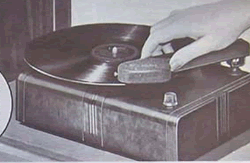During the 1920s, 1930s and 1940s, there were numerous experiments with new kinds of electrical recordings and long-playing, often larger discs were in use in the motion picture and radio industries. There were even experiments with multi-channel recording. But through all this, the standard 10- and 12-inch discs remained the standard consumer products.
 It was not until after World War II that new technologies displaced the standard disc. RCA introduced a new disc in 1948 that used finely spaced grooves to pack about the same amount of music into a smaller 7-inch record. The company boasted that its improved plastic composition, along with improved recording and reproduction equipment, provided better sound. The next year, Columbia introduced its Long Playing format with a groove that was close enough to be compatible with the RCA disc (although the had different sized center holes). Besides the center holes, the biggest difference was that Columbia pushed the new format as a replacement for the box-set “albums” of discs that were usually associated with longer pieced of classical music, “best of” compilations, and Broadway or Hollywood soundtrack collections. Thus, while small LP records were possible, Columbia promoted a larger, 12-inch or 10-inch diameter version. The RCA 45-rpm disc, on the other hand, was a direct replacement for the standard single record, and while record companies began to offer boxed “albums” of RCA discs, in the longer term, the format was much more successful as a medium for “hit” singles. While the 12-inch LP and the 7-inch microgroove single discs co-existed for decades after that, it was arguably the success of the smaller disc that doomed the older type of records, which were now known, like the ’45,’ by their speed of rotation– 78 rpm. Contributing to the change, record companies gradually abandoned the old type of disc, leaving consumers little choice. Most people did not simply abandon their record collections, and most record players had a ’78’ setting into the 1980s (and sometimes, in the early 21st century phonograph revival, even today). However, sales of 78-rpm discs declined during the 1950s, and virtually gone in the US and western Europe by about 1960.
It was not until after World War II that new technologies displaced the standard disc. RCA introduced a new disc in 1948 that used finely spaced grooves to pack about the same amount of music into a smaller 7-inch record. The company boasted that its improved plastic composition, along with improved recording and reproduction equipment, provided better sound. The next year, Columbia introduced its Long Playing format with a groove that was close enough to be compatible with the RCA disc (although the had different sized center holes). Besides the center holes, the biggest difference was that Columbia pushed the new format as a replacement for the box-set “albums” of discs that were usually associated with longer pieced of classical music, “best of” compilations, and Broadway or Hollywood soundtrack collections. Thus, while small LP records were possible, Columbia promoted a larger, 12-inch or 10-inch diameter version. The RCA 45-rpm disc, on the other hand, was a direct replacement for the standard single record, and while record companies began to offer boxed “albums” of RCA discs, in the longer term, the format was much more successful as a medium for “hit” singles. While the 12-inch LP and the 7-inch microgroove single discs co-existed for decades after that, it was arguably the success of the smaller disc that doomed the older type of records, which were now known, like the ’45,’ by their speed of rotation– 78 rpm. Contributing to the change, record companies gradually abandoned the old type of disc, leaving consumers little choice. Most people did not simply abandon their record collections, and most record players had a ’78’ setting into the 1980s (and sometimes, in the early 21st century phonograph revival, even today). However, sales of 78-rpm discs declined during the 1950s, and virtually gone in the US and western Europe by about 1960.
The date of the very last 78-rpm record is not known, although some claim that the last one issued in the U.S. was Chuck Berry’s “Too Pooped to Pop ” (Chess 1747), released in February 1960. There were almost certainly later released on small labels, and there are documented cases of 78 discs released as late as 1961 in Finland. According to one source, 78s were deleted from the EMI catalogs in 1962. More recently, it has been rediscovered that in some countries, 78-rpm disc production continued even later.
It’s worth mentioning that Moby Grape’s 1968 album Wow, featured a song that was recorded at 78 rpm, but it was recorded on an LP disc that otherwise played at 33 1/3 rpm.
[End]